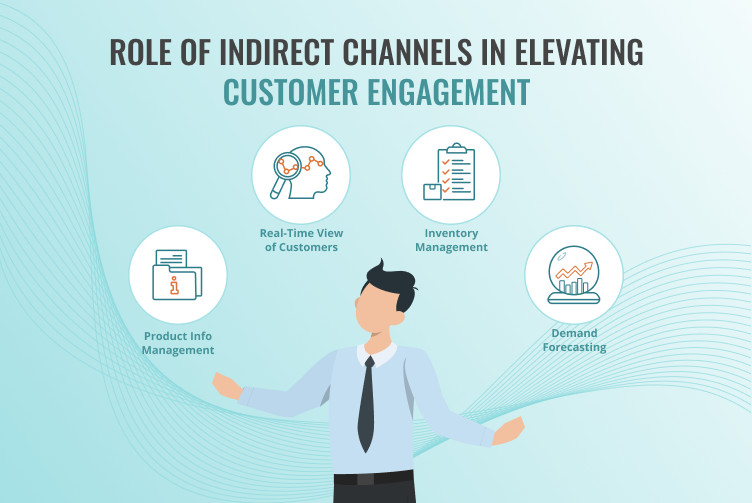Today, over 88% of business leaders believe that customer engagement significantly influences their organisation’s bottom line. With the shifting focus from selling products to experiences, customer engagement has become extremely important. But how to achieve best-in-class customer engagement for your business?
Mostly, you will hear about digital channels, customer service, and brand experience centres as central to improving customer engagement, but the front face of a business is the downstream retailer or distributor. That is where customers experience the product and develop a perception. So, it’s critical that distribution channels are included in the overall customer engagement strategies.
How Does an Indirect Channel Play a Key Role in Elevating Customer Engagement?
Smart Product Information Management
Organising a complex set of products can be challenging for most distributors because of varied product specifications. The inability to create a centralised product information repository with updated content concerning products impacts customer engagement and experience.
It’s important that field sales agents, distributors, and other indirect sales channels are well-informed and equipped with complete and real-time product information. This can help them better understand customer needs and interests and how the market is evolving. This knowledge can then be used to inform sales efforts and drive targeted customer engagement.
Robust Inventory Management
Robust inventory management is crucial for driving customer engagement. Keeping track of products coming in and out can help distributors ensure that the orders are fulfilled on time. Contrarily, poor inventory management increases the frustration of all the stakeholders involved and leads to missed opportunities to develop a sound relationship with customers.
Manual handling of inventory is error-prone and time-consuming. Therefore, distributors must be equipped with a robust inventory management technology solution to ensure accuracy and smooth order fulfilment.
360-Degree Real-Time View of the Customer
Distributors help develop the capabilities to respond to market needs faster and deliver as per customers’ requirements. A comprehensive, 360-degree real-time view of the customer helps them drive many reselling and upselling opportunities. These insights can also be leveraged to identify usage patterns and create contextual customer engagement strategies.
Altogether, the indirect sales channel helps identify and leverage cross-sales, service the customers better, and enhance customer engagement.
Improved Demand Forecasting
The indirect sales channel helps improve future planning capabilities by gaining insights into changing customer needs. With the evolving demands, distributors can ensure improved inventory planning and supply chain management.
When demand forecasting is appropriately carried out, the out-of-stock and overstock situations can be adequately managed. This ensures that distributors do not waste money by tying unnecessary cash in inventory and reduce the negative impact on customer service due to outdated stock.
Advantages of the Indirect Channel in Realising Customer Engagement
Tapping Into an Existing Customer Base
When businesses work with resellers, distributors, and other indirect channels, they are more likely to reach more customers because of the recognition of the brand partner. Customers know the brand and easily trust their products or services. It ensures excellent service delivery and drives great customer engagement.
Indirect Sales are Cost-Efficient
The indirect channels mostly rely on their sales and marketing network and use their standard procedures to deliver efficient results. When the established processes, systems, and logistics are leveraged, there is a great potential for cost reduction as compared to owned outlets.
Indirect Sales Increase Speed to Market
Often, businesses don’t have a sales team or a presence in a new market or region. That’s where indirect channels can help them enter new markets easily and quickly at a meagre cost and risk. It allows them to increase their geographic footprint, enhance their customer base, and drive better customer engagement.
Established Logistics
Resellers and distributors have their logistical infrastructure in place, providing an excellent opportunity to scale business operations. While starting up to create marketing and logistics operations and hiring staff can become a considerable burden, leveraging the partner’s established logistics can help accelerate the business processes, improve products or services, and engage customers better.
Challenges in Engaging Customers with Indirect Channels
Data shift Challenges
With the ever-increasing marketing channels, customers are generating more data every day. At the same time, storing, managing, and leveraging the data has become a major challenge for businesses. Managing the data effectively can help gain critical customer insights to drive better customer engagement and conversions.
Favourably, an integrated insights solution can help you gather the data, capitalise on maximum business opportunities, and act in real time.
Siloed Marketing and Sales Channels
Driving customer engagement has become challenging due to the usage of multiple marketing channels – for example, running a season sale on your mobile app but not on a website or promoting a discount via email but not on social media.
Using cross-channel platforms for indirect channels can integrate business operations to generate more purchases and drive higher customer engagement and loyalty.
Missing Personalisation Opportunities
Over 80% of consumers are more likely to purchase from a brand that offers a personalised experience. When personal information like interest, location, buying history, and other preferences are collected, this data can be used to drive personalised offerings and promotions. However, collecting consumer data without an integrated technology solution is challenging, something that businesses must take note of for leveraging personalisation opportunities.
How Can Brands Improve Customer Engagement With an Integrated Solution?
While most customer engagement strategies are accommodated using digital channels, the real face of the brand is the downstream retailer and indirect sales channel, including resellers and distributors. So, it is imperative to ensure a robust information network between the brand and distributors for effective coordination.
Leveraging an integrated technology solution for an indirect channel can be a game changer for your business as it provides real-time business information, integrates all business operations, eliminates channel conflicts and costs, manages coordination issues, and much more.
Get in touch with us to explore how this solution can help your business drive customer engagement.




